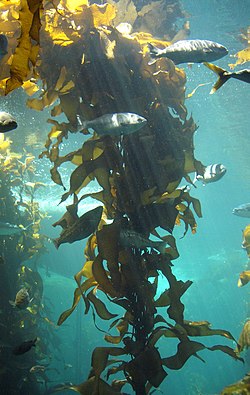Urchin barren
Urchin barrens are places in the ocean where sea urchins have eaten and killed so many kelp plants that they turned a kelp forest into something like a desert. This happens when there are too many sea urchins. The fish, krill and other animals that live in the kelp either die or leave. Urchin barrens occur in coastal areas of the Pacific Ocean.[1][2]
Urchin barrens had been forming for a long time, but in the second half of the 2010s, there were suddenly many more.[3]
Causes

People first noticed urchin barrens in the 1800s when the sea otters were hunted for their fur. People killed so many sea otters that they almost went extinct. Sea otters like to eat sea urchins, so without sea otters to eat them, there were many, many sea urchins.[2]
Warm ocean currents also affect sea urchin populations. In some places, kelp forests turn into urchin barrens and then grow back depending on the currents that year.[1]
Starfish also eat sea urchins. The sunflower starfish is the only animal that regularly eats the purple sea urchin. Even sea otters like red sea urchins more than they like purple sea urchins. When a disease in 2013 killed most of the starfish on the Pacific coast, there were many more purple sea urchins left. One study showed that the number of purple sea urchins in one reef off the coast of Oregon increased 10,000% in the five years between 2014 and 2019. They either ate or crowded out the red abalone and red sea urchins that humans like to eat. The abalone fishery in California closed in 2018, a loss of US$44 million per year.[3]
When purple sea urchins run out of food, they try to eat each other, and then they become dormant, as if sleeping. They do not try to reproduce, so their gonads shrink. Because the gonads are the part of the urchin that humans like to eat, dormant purple sea urchins cannot be caught and sold for food.[3]
Climate change
Scientists said the warmer water in the early 2010s weakened the bull kelp.[3] In 2016, a mass of warm water nicknamed the "Blob" kept the coast of California very warm.[1] The warm water also made it easier for the sea urchins to reproduce, so they had many more young than usual.
A study showed that 90% of the bull kelp off the coast of California had been killed in the late 2010s.[3]
Restoration
Scientists performed tank and ocean experiments on other animals, such as lobsters, to see if they would eat enough purple sea urchins to help the kelp forests grow back, but they only helped a little.[4]
In places where sea otters have returned, like Juan de Fuca Strait, they ate enough sea urchins that the kelp forests grew back.[1]
Some companies hired red abalone divers to collect purple sea urchins and bring them to controlled sea ranches where they could be fed until they were healthy enough to sell for human use.[3]
Urchin Barren Media
References
- ↑ 1.0 1.1 1.2 1.3 Doug Simpson (February 2017). Underwater Barrens: Monitoring the fate of Southern Californian kelp requires a long view.. Natural History Magazine. https://naturalhistorymag.com/features/153361/underwater-barrens. Retrieved May 22, 2020.
- ↑ 2.0 2.1 "With otters away, what keeps urchins at bay?". California Sea Grant. March 14, 2019. Archived from the original on September 29, 2020. Retrieved May 22, 2020.
- ↑ 3.0 3.1 3.2 3.3 3.4 3.5 Sea urchin population soars 10,000% in five years, devastating US coastline. Guardian. October 24, 2019. https://www.theguardian.com/environment/2019/oct/24/sea-urchins-california-oregon-population. Retrieved May 24, 2020.
- ↑ Robert P. Dunn; Kevin A. Hovel (January 16, 2019). "Experiments reveal limited top-down control of key herbivores in southern California kelp forests". Ecology. 100 (3): e02625. doi:10.1002/ecy.2625. PMID 30648729. S2CID 58571539. Archived from the original on January 13, 2022. Retrieved May 25, 2020.




